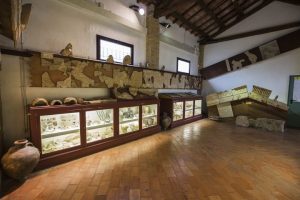
The small but valuable Antiquarium museum set up in the area in front of the castle preserves the important materials found in over forty years of excavation in the sacred area of Pyrgi, as well as extensive graphic and photographic documentation. Pyrgi, the port of the ancient Caere, then Cerveteri, from which it was about 13 km distant, enjoyed among the Etruscans of great fame also for its sanctuary.
Excavations carried out at the suggestive Castle of Santa Severa have brought to light two temples and other cultic fortifications. The oldest one (temple B) is dedicated to the divinity Uni, assimilated to the Phoenician Astarte and dated back to the end of the VI century BC.
The most recent and most majestic (temple A) dates back to the first half of the V century BC and is dedicated to the Greek Leukothea. She was the goddess of dawn associated with the generation of life, with which Cere intended to reaffirm its power after the defeat suffered by the Etruscans in 474 BC against the Greeks of Syracuse in the waters of Cumae.
Temple A, preserved as the nearby temple B only in its mighty foundations, was decorated with terracotta high reliefs; the central one, representing one of the culminating moments of the Greek myth of the Seven in Thebes, was the subject of a complex restoration and is now exhibited at the Museum of Villa Giulia.
Of extraordinary importance is the discovery in 1964 of the famous gold leaves, of Etruscan and Phoenician era, which recall the dedication of the temple by the ‘king of Caere’ Thefarie Velianas to the goddess Uni / Astarte. A copy of the ancient leaves is present in the museum, where you can admire an exhibition of fragments of various ceramics, terracotta overlapping the wooden roof and a high relief that represents a Gigantomachy in proportion of three quarters with respect to the real sizes.
[ngg_images source=”galleries” container_ids=”7″ display_type=”photocrati-nextgen_basic_imagebrowser” ajax_pagination=”1″ order_by=”sortorder” order_direction=”ASC” returns=”included” maximum_entity_count=”500″]